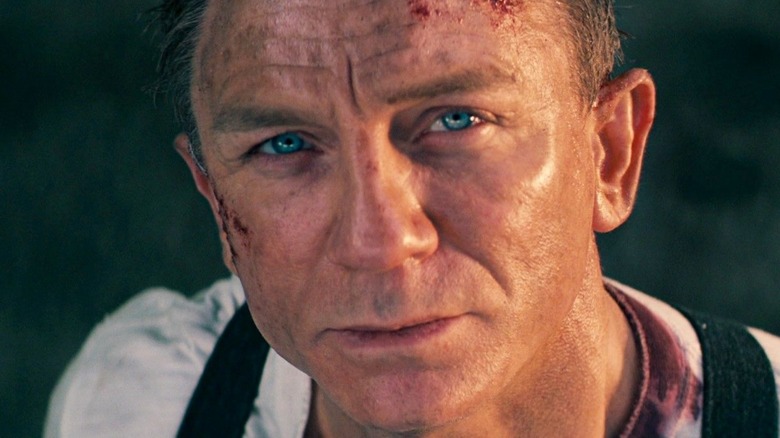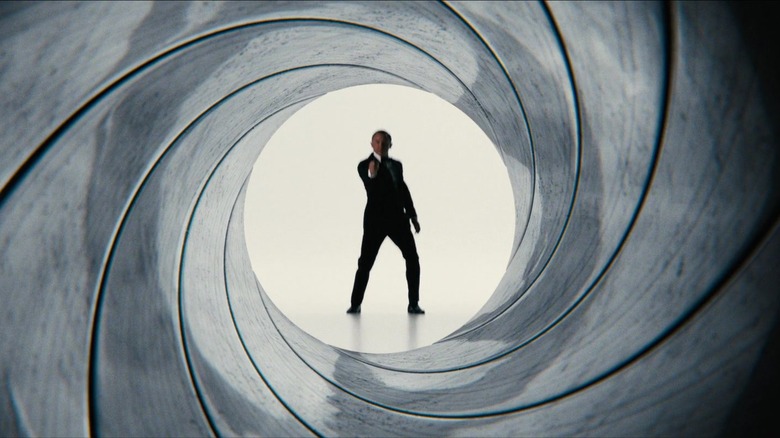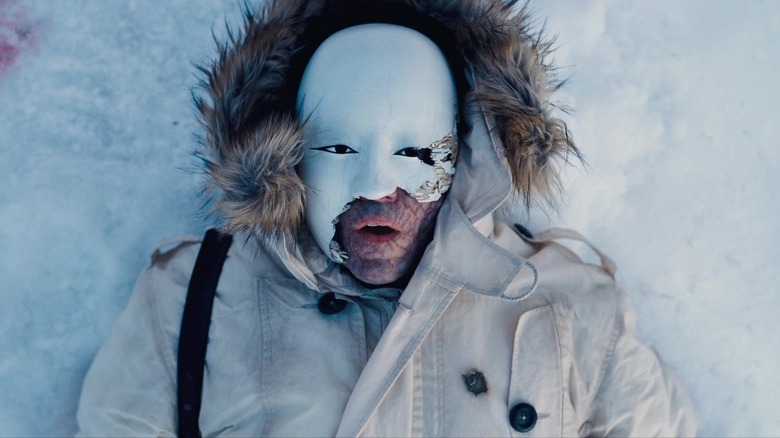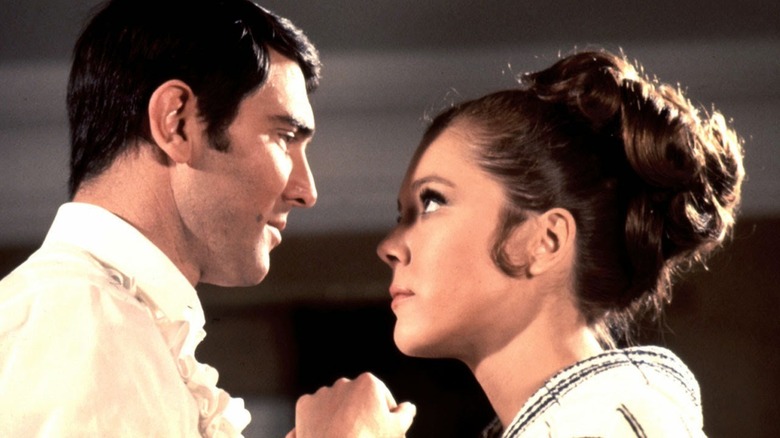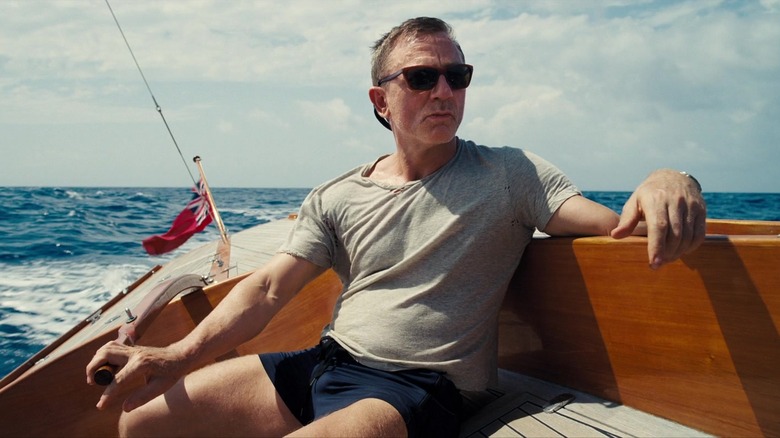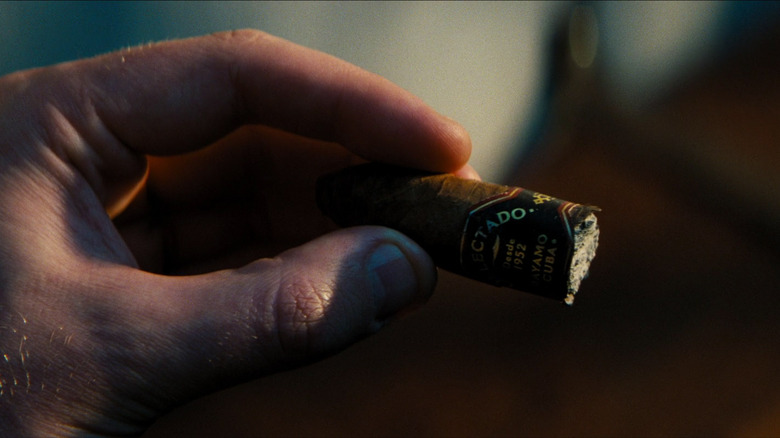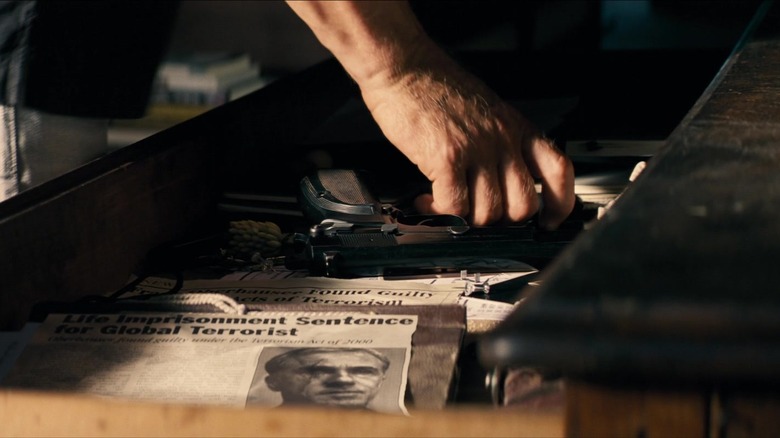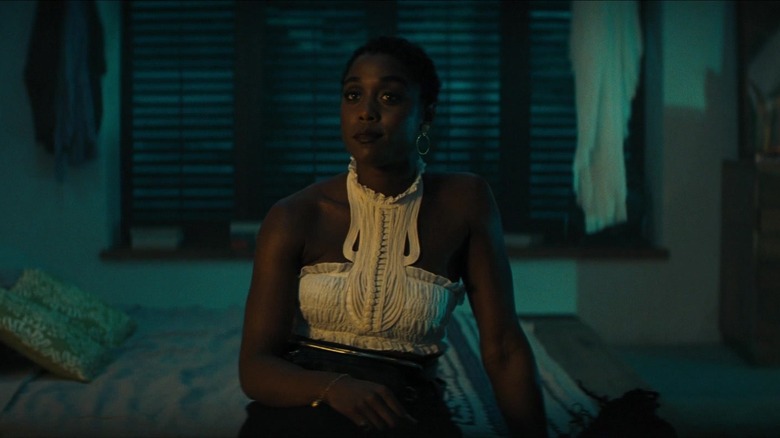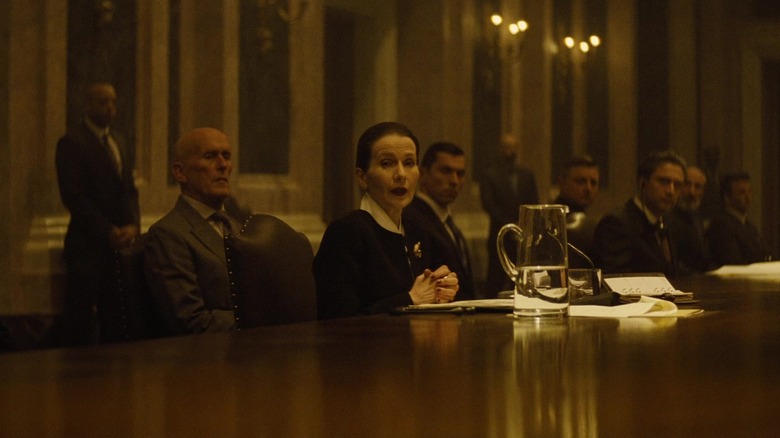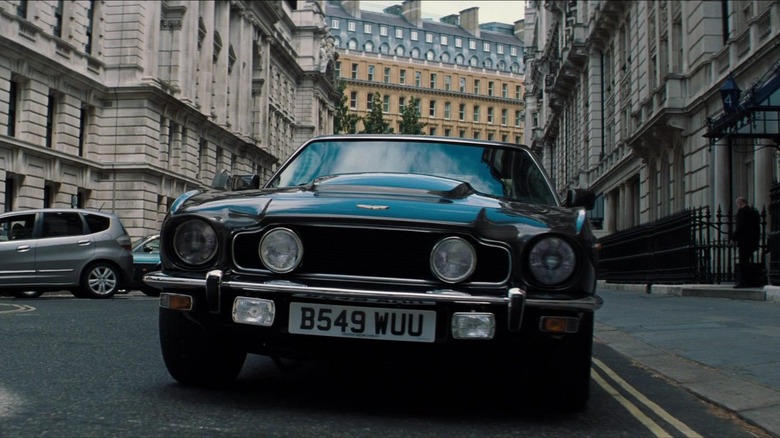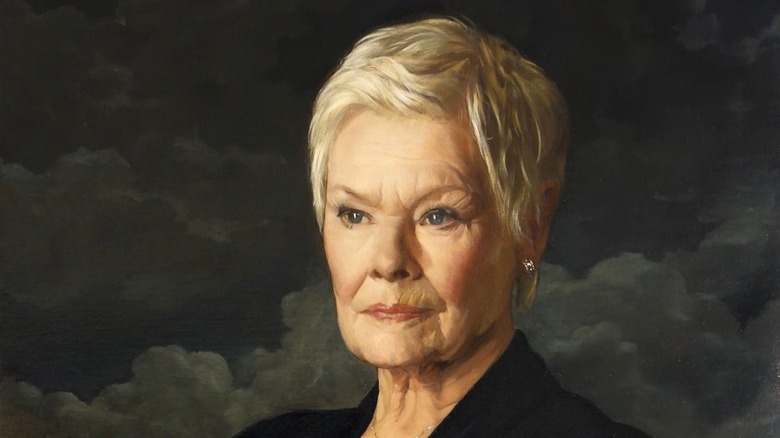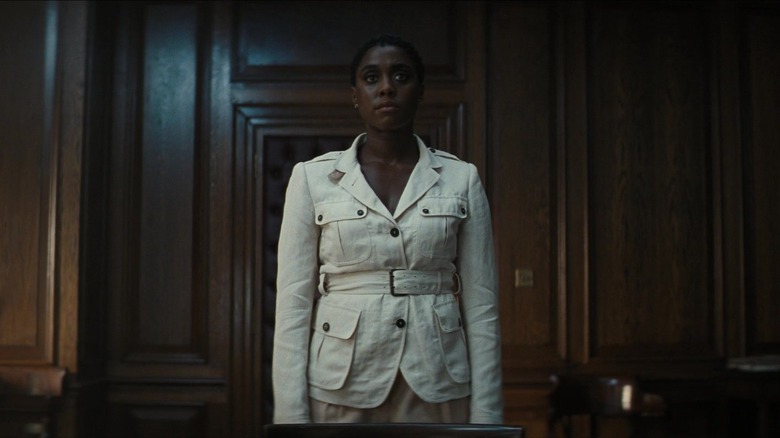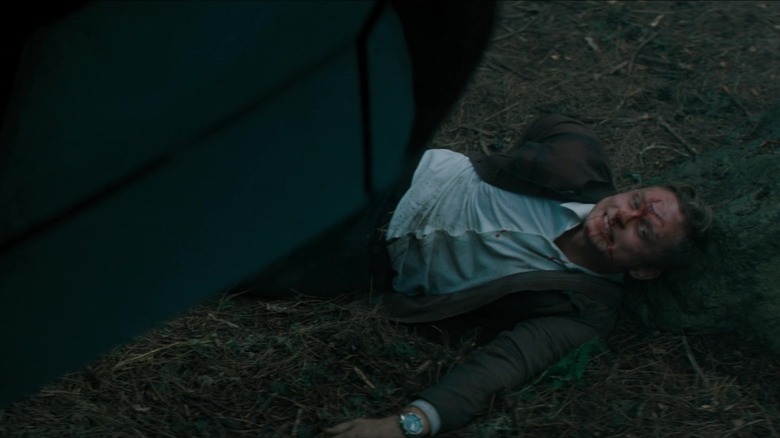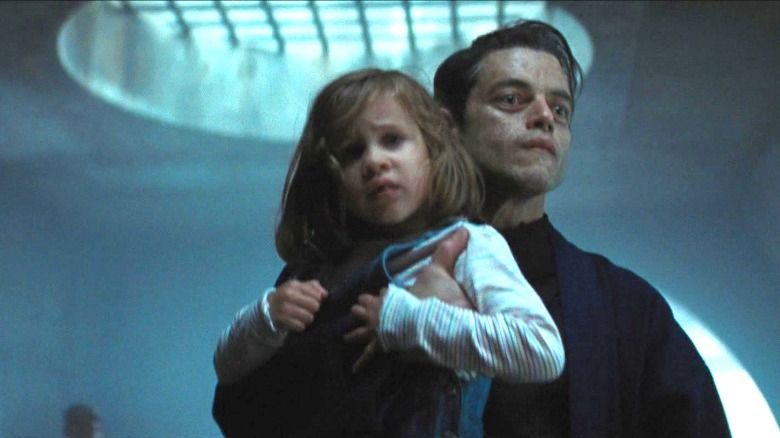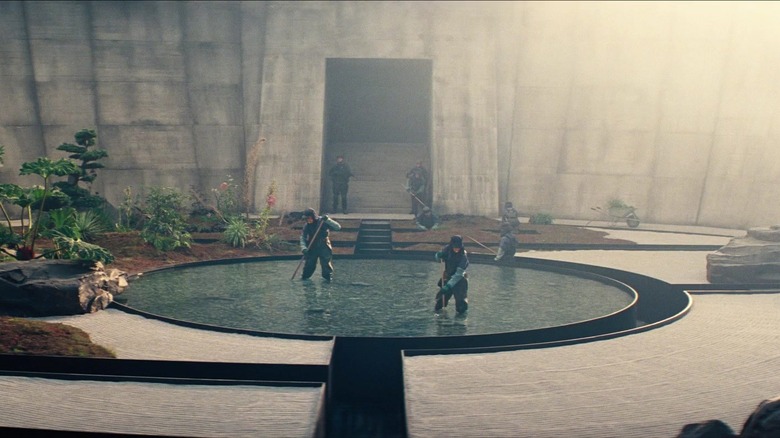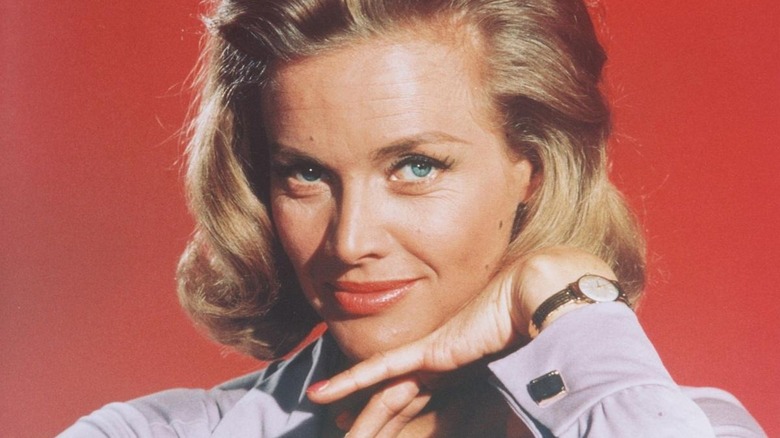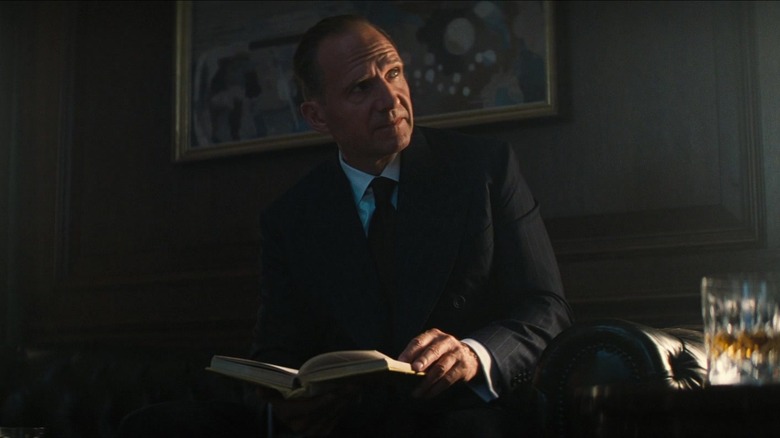16 Easter Eggs In No Time To Die You May Have Missed
"No Time to Die," the 25th installment in EON Productions' James Bond series–and the final appearance of Daniel Craig in the iconic role–commemorated the franchise's silver anniversary with multiple references and callbacks to the history of the character on the screen and page. Speaking with The Official James Bond Podcast, veteran Bond producer Barbara Broccoli expressed that, "We wanted this film to really be an homage to all of the films that have come before."
The Bond films have been reverential since they first hit the screen, sometimes gratingly so (Bond's Tarzan yell in "Octopussy" and the "Close Encounters of the Third Kind" melody on the security keypad in "Moonraker," for example). They've also been extensively self-referential, though "No Time to Die" takes that tradition to a whole new level. Here are a few of the Easter Eggs in "No Time to Die" that you may have missed. Spoiler warning: from the jump, this article will be discussing plot details including the shocking finale of "No Time to Die."
The opening gun barrel sequence foreshadows the ending
The Daniel Craig era of the Bond series has been one of the most experimental when it comes to the iconic gun barrel opening that has been a franchise staple since 1962's "Dr. No." You may recall that "Casino Royale" tweaked the old standby by incorporating it into the narrative via a black-and-white pre-title sequence. "Quantum of Solace" and "Skyfall" saved the sequence for their conclusions, though "Skyfall" also opened with a shot that serves as a subtle homage.
"No Time to Die" is no exception. Instead of blood oozing down the screen after Bond fires his Walther PPK at the camera, the frame ominously fades to white, creating a sense of unease that portends the character's ultimate demise.
"No Time to Die" does something similar during the climax at Safin's lair, with a shot of Bond turning to camera with his weapon drawn in a tunnel; director Cary Joji Fukunaga revealed on The Official James Bond Podcast that this was actually an impromptu idea that came to him on set. "No Time to Die" later triples down on this visual motif in its final frames, as Madeleine Swann (Léa Seydoux) and her daughter Mathilde drive off into an uncertain future through a tunnel.
Safin's ties to Dr. No
In the chilling cold open of "No Time to Die," Rami Malek's villainous Lyutsifer Safin wears a Noh mask, a Japanese theater tradition that dates back to the 14th century. This could be a pun on Dr. No, the first evil genius to square off against Bond on screen.
The mask works as a disguise, hiding Safin's chemically scarred visage, and as an intimidation tactic. "No Time to Die" costume designer Suttirat Anne Larlarb told Esquire Magazine, "When [the mask] was lit from different angles, the expressionless face changed so much with each shot. It was aggressive, then serene, then terrifying, then caring..." Curiously, Safin's Noh appears to be a Zo-onna mask, which are used in kabuki performances to represent female characters.
The similarities to "Dr. No" don't end there, either. The workers at Safin's factory (some of whom were actually created via motion capture performances) wear hazmat suits strongly reminiscent of the ones donned by Dr. No and his nuclear technicians.
The connections to On Her Majesty's Secret Service
"No Time to Die" is heavily indebted to 1969's "On Her Majesty's Secret Service," which director Cary Joji Fukunaga cited as one of his favorite Bond films in an interview with The Hollywood Reporter. According to Fukunaga, the idea to incorporate elements of that film into "No Time to Die" came very early in the production process. When we reunite with Bond and Madeleine in the first act of the film, you can hear a reprise of John Barry's lush, romantic "We Have All the Time in the World (James Bond's Theme)" in composer Hans Zimmer's "Matera." As 007 fans know, the former song takes its title from Bond's parting words to his slain wife, Tracy, in "On Her Majesty's Secret Service."
"No Time to Die" also sees the MI6 agent repeating that phrase as his last words to Madeleine before his tragic death on Safin's island. The rendition of "We Have All the Time in the World," with vocals by Louis Armstrong (taken from the opening titles of "On Her Majesty's Secret Service"), plays over the end credits of the 25th Bond film. Finally, in an interview with the aforementioned Official James Bond Podcast, Barbara Broccoli said, "The emotional context of this film is definitely deeply imbued with the film 'On Her Majesty's Secret Service.'"
A visit to Jamaica
The island of Jamaica is a popular destination in the Bond series, with 007 having previously enjoyed its tropical environs in "Dr. No" and "Live and Let Die." The novel "The Man With the Golden Gun" is also set on the island. What's more, the Bond girls Solitaire and Domino borrow their names from birds native to the region; appropriately, James Bond's namesake is a British ornithologist who lived in Jamaica.
"No Time to Die" sees the character briefly retired from service and living in a modest abode not unlike the one where Bond creator Ian Fleming dreamt up the character. For the "No Time to Die" set, the production designers even went as far as to recreate Fleming's writing desk from his Jamaican estate, Goldeneye, which was named after a top-secret World War II operation planned by Fleming. For the initial press conference for "No Time to Die," EON Productions broadcast live from Goldeneye (now a world class resort) in April of 2019.
The Delectado cigar and Die Another Day
Bond is first tipped off to the presence of his old colleague and "brother from Langley" Felix Leiter when he finds the stub of a Delectado cigar in his home. Later, another one — given to Bond by Agent Paloma (Ana de Armas) and intended as a gift for Leiter — is all he has left to remember his fallen friend. Delectado cigars previously appeared in "Die Another Day," specifically when Pierce Brosnan's 007 paid a visit to a Cuban cigar factory, where he used the code phrase "discontinued cigar."
As The Gentleman's Journal reminds us, although Bond creator Ian Fleming detested cigars, his best-known character enjoyed them in "Live and Let Die" and "The Man with the Golden Gun," both of which star real-life cigar aficionado Sir Roger Moore. While Moore never made the cover of Cigar Aficionado Magazine, Bonds Connery, Craig, and Brosnan did (the latter twice).
The return of Blofeld
When Bond stashes his pistol in the secret compartment of his dresser, the return of Christoph Waltz's Ernst Stavro Blofeld (aka Franz Oberhauser) is telegraphed by a fleeting glimpse of a newspaper headline that reads "Life Imprisonment Sentence for Global Terrorist," with the subhead "Oberhauser found guilty under the Terrorism Act of 2000." Waltz's return to the franchise was kept secret until an announcement in July 2019.
But Blofeld isn't the only Bond villain to get a shout out in print. When Madeleine shows Bond the Russian newspaper article about the murder of Safin's parents and three siblings at the hands of SPECTRE's Mister White, it includes a mention of a "Doctor Zorin." Christopher Walken played the sinister Silicon Valley mogul Max Zorin in "A View to a Kill." While clearly not meant to be the same character (Walken's Zorin was a French industrialist and secret Nazi Übermensch), it's nonetheless a cool little Easter Egg hidden in the set dressing.
'The one that works'
When Lashana Lynch's M. M. Nomi threatens to shoot Bond in the knee if he doesn't stay out of her way, she specifies, "The one that works." This could be the filmmakers having some fun at Daniel Craig's expense.
While filming his brutal train car fight with Dave Bautista's SPECTRE heavy Mr. Hinx in "Spectre," Craig ruptured the anterior cruciate ligament in his knee, causing production to temporarily shut down and requiring multiple surgeries. Once filming resumed, he had to complete the film while wearing a knee brace that was digitally erased in post-production.
That said, Craig got his revenge when filming resumed, punching his co-star and former professional wrestler so hard that Bautista started bleeding from his nose. Bautista would later claim Craig had actually broken it, and even shared a photo of the aftermath on Twitter. Misfortunes like these seem to be par for the course on Bond sets, though — Craig's busted knee was only one of the many brutal injuries that he sustained during his tenure as Bond.
Familiar faces at Blofeld's birthday bash
Eagled-eyed viewers may have spotted some blink-and-you-miss-it cameos at the SPECTRE party thrown in Havana. For example, Brigitte Millar can be glimpsed reprising her role as agent Dr. Vogel. Vogel first appeared as a member of the criminal syndicate's Board of Directors at their clandestine meeting in Rome in "Spectre." There, her dialog marked her as a high-ranking member of the nefarious terrorist organization and a pivotal figure in SPECTRE's human trafficking and surveilence operations.
Longtime Bond producer Micheal G. Wilson can also be seen briefly at the party. Wilson is the stepson of famed Bond producer Albert "Cubby" Broccoli, and has appeared onscreen in 13 other Bond films, playing everything from a Greek priest to a member of the Russian Security Council. He also lent his voice to "A View to a Kill" and "License to Kill."
The Aston Martin V8 Vantage Series III
When Bond returns to London to confront M at MI6 headquarters, he can be seen driving one of the coolest vehicles in Bond's storied history: the Aston Martin V8 Vantage Series III, as seen in 1987's "The Living Daylights." Even the license plate (B549WUU) matches. Unfortunately not depicted: the car's awesome ski-like extensions for driving on ice, which could've been handy when Bond rescues Madeleine and Mathilde from Safin's goons in Norway.
The unmistakable Aston Martin DB5, which sustains some serious damage in "No Time to Die," also returns, having previously appeared in "Goldfinger," "Thunderball," "GoldenEye," "Tomorrow Never Dies," "Casino Royale," and "Spectre." One more vehicle from Bond lore makes a cameo, too. Agent Paloma crashes a 1957 Chevrolet Bel Air into some scaffolding in Havana while pursuing Doctor Valdo Obrachev; an undercover agent chauffeured Bond in a '57 Bel Air in "Dr. No."
The Ms of years past
At MI6 headquarters, you can glimpse portraits of three of Ralph Feinnes' predecessors as M: Dame Judi Dench, Bernard Lee, and Robert Brown. As revealed on The Official James Bond Podcast, set designer Vérenique Melery struck upon the idea of including the portraits when exploring the EON Productions archives. Lee's portrait previously appeared in "The World Is Not Enough," while the portraits of Brown and Dench were commissioned specifically for "No Time to Die." In another reference to Dench's M, the ceramic Bulldog with Union Jack paperweight that she bequeathed to Bond at the conclusion of "Skyfall" can be spotted in Bond's London storage locker, the hiding place of his Aston Martin DB5 in that film.
In the background, you can also see Bond that has stashed a pair of skis in his locker. While we've never seen Craig's Bond hit the slopes, skiing is a recurring trope in the Bond series, having appeared in "On Her Majesty's Secret Service," "The Spy Who Loved Me," "For Your Eyes Only," "A View to a Kill" and "The World Is Not Enough."
The safari jacket returns
Nomi, the latest agent to bear the 007 codename, can be seen wearing a fashionable white safari jacket at the Universal Exports offices. Her look harkens back to Sir Roger Moore's penchant for wearing similar attire, as seen in "Live and Let Die," "The Spy Who Loved Me," "Moonraker," and "Octopussy," among other films. As Bond Suits observes, Nomi's "White Lily" linen jacket recalls the one Moore wears in his second outing as Bond, 1974's "The Man with the Golden Gun," and was designed by renowned fashion designer and filmmaker Tom Ford, who has been associated with the Bond franchise since "Quantum of Solace." Sadly, even if you have nearly $3,000 to spare, if you want to sport the look yourself you're out of luck — this particular design appears to be sold out.
Nomi's safari jacket is an unusual choice, but it's likely something she had packed for the warmer climates of Jamaica and Cuba, and she probably didn't have a chance to change into a more traditional outfit before rushing back to London to intercept Bond.
The death of Logan Ash
Bond's murder of treacherous CIA Agent Logan Ash (Billy Magnussen) also recalls the Moore era, specifically 1981's "For Your Eyes Only." In that film, Bond dispatches a henchman named Locque by kicking his teetering car off of a cliff. Moore has been vocal with his displeasure at the brutality of the moment, stating that he felt the cold-blooded act was "Bond-like, but not Roger Moore Bond-like." Nevertheless, he acquiesced to the wishes of first-time Bond director John Glen (who later helmed "Octopussy," "A View to a Kill," "The Living Daylights" and "License to Kill"), and a Bond moment was born that was so memorable that the filmmakers of "No Time to Die" felt the need to reference it.
That scene certainly had a harder edge than was typical of Moore's take on Commander Bond, but Craig's Bond is a different story. He's a "blunt instrument" with a "history of violence," so it makes sense that he should take his revenge for Felix Leiter's death in a similarly violent fashion, crushing Ash to death with a casual push on a Land Rover Defender 110 SUV.
Honoring the great Ken Adam
In yet another tribute to the first film in the James Bond series, the set for Safin's lair includes many of the hallmarks of legendary Bond production designer Ken Adam. In the "No Time to Die" home video bonus features, designer Mark Tildesley credits Adam, who created the sets for "Dr. No," "Goldfinger," "Thunderball," "You Only Live Twice," "Diamonds Are Forever," "The Spy Who Loved Me," and "Moonraker," as a direct influence.
With its wide-open spaces, harsh angles, circular doorways, and Brutalist architecture, Safin's hideout is reminiscent of Adam's designs for previous Bond villain lairs. One specific reference is the circular skylight with iron bars that can be seen overhead when Safin is on the run with a kidnapped Mathilde. That resembles the dramatically lit tarantula torture room from "Dr. No." When discussing that set, Adam is quoted in TASCHEN's remarkable "The James Bond Archives" as saying, "I wanted to design an impressive set, so I came up with this circular overhead opening with a grid, a bare set with just one chair ... [director Terence Young] loved it, and he said, 'Ken, can you give me a bit more of the ceiling, and [a] bit more inclination, so I can really go back.' And that's what we did."
The poison garden
Safin menaces Mathilde in front of Madeleine in the "poison garden" where he and his lackeys developed Heracles, the film's deadly nanovirus. This is a nod to Fleming's novel "You Only Live Twice" and its villain Dr. Guntram Shatterhand, who maintains a "Garden of Death." In the book, the Garden of Death is located in a castle on the volcanic Japanese island of Kyushu. In "No Time to Die," Safin's island can be found in disputed waters between Japan and Russia, leading to a diplomatic crisis for Fiennes' M in the movie's gripping climax. In another tribute to "You Only Live Twice," Safin's garden is also of the Japanese Karesansui variety, with immaculately raked sand; the garden is of SPECTRE origin in both the novel and film.
"You Only Live Twice" subsequently reveals that Dr. Shatterhand is none other than Ernst Stavro Blofeld, Bond's arch enemy. In Fleming's novel, Bond murders Blofeld, forming another parallel to "No Time to Die."
References 'Galore'
How's this for obscure? The font used in the marketing for "No Time to Die" is called Futura Black. Designed by Paul Renner in the late 1920s, the typeface was also used on the cover of the first edition of "The Book of Self Defense" by Honor Blackman. Blackman is best known for portraying the classic Bond femme fatale Pussy Galore in "Goldfinger."
Incidentally, the font was also used for a Schick razor ad featuring Roger Moore, as pointed out by noted Bond expert Phil Nobile Jr. on Twitter. A 1984 paperback edition of Robert M. Pirsig's "Zen and the Art of Motorcycle Maintenance" also utilized Futura Black. A copy of the cult nonfiction book can be seen in Bond's Jamaican dwelling towards the beginning of "No Time to Die"; notably, Craig's Bond rode a Montesa Corta 4RT motorcycle in "Quantum of Solace," a Honda CRF250R in "Skyfall," and a Triumph Scrambler 1200 XE in "No Time to Die."
A fitting euology
As M, Moneypenny, Tanner, and Q mourn Bond's sacrifice, M quotes author Jack London. In the San Francisco Bulletin in 1916, London wrote, "The proper function of man is to live, not to exist. I shall not waste my days in trying to prolong them. I shall use my time." London's quote was also used as the introduction to a posthumous collection of his short stories, which was published in 1956.
This same passage was used by Fleming in the novel "You Only Live Twice" as part of an obituary for the superspy (which turns out to be a ruse in both the book and in EON's film adaptation). In the novel, the quote was added to Bond's obit by his sometime-lover Mary Goodnight. While Goodnight was a recurring character in Fleming's books, she only appeared once on screen, portrayed by actress Britt Ecklund in "The Man with the Golden Gun."
